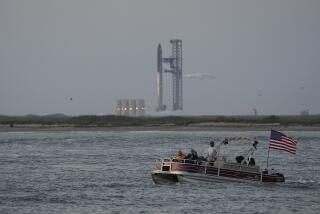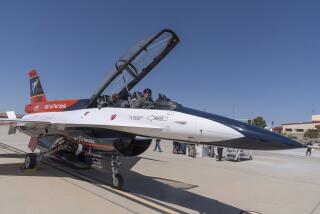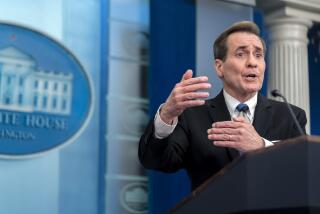30 Years Later : Sputnik: Soviet Feat Brought Global Change
- Share via
MOSCOW — The message was little more than a series of haunting “beeps,” but it sent scientists around the world scurrying for their radio receivers to see for themselves if the Soviet Union indeed had launched the first man-made satellite.
At about the same time, the United States was gearing up to launch the first payload into orbit, and few had taken the Soviet Union’s upstart space program seriously. Instead, they scoffed at the Soviet Union’s claims that it would orbit a satellite during 1957, during an extraordinary 18-month period of global cooperation known as the International Geophysical Year.
But Gene Giberson of the Jet Propulsion Laboratory in Pasadena, which was then a research facility for the U.S. Army, remembers well, 30 years later, the events of that day, Oct 4, 1957.
Monitoring the Signal
“I can remember grabbing a couple of our guys and rounding up some radio receivers and heading for the roof of one of the buildings over here,” he recalled during a recent interview at JPL. Guessing at the frequency that the satellite would be using, the engineers soon picked up the signal.
“It didn’t take long,” he said, and the engineers quickly determined that the satellite was passing overhead every 90 minutes.
“So you knew it was in orbit, and it wasn’t just a flash-in-the-pan ballistic vehicle,” Giberson said. “Man, it sent shivers down my spine.”
This week, the Soviet Union is celebrating the 30th anniversary of the launching of Sputnik 1 with an extraordinary three-day scientific symposium, focused on future space programs, which opened Friday in Moscow. Scientists from around the world, including more than 100 from the United States, have traveled to the Soviet capital to mark an event that changed forever the complexion of geopolitics, an achievement that both excited and terrified a world that had only recently entered the nuclear age.
At the conference on Friday, the Soviet Union made a strong pitch for the creation of a World Space Institute, in which all nations could join together in the peaceful exploration of space.
“Cooperation in space must serve as the bridge” between the major space powers, Gury Marchuk, president of the Soviet Academy of Science, said. One way to do that, he added, would be through the creation of an international, nonprofit institute that could function as an arm of the United Nations, bringing together such diverse countries as the United States and the Soviet Union in the “peaceful use of space.”
Mankind’s Bold Adventure
Sputnik launched the human race on one of its boldest adventures, the exploration of space--first through sophisticated robotic satellites and later by men and women who became the first of their species to break at least temporarily their bond with planet Earth. Orbiting communications satellites turned the world into a global village with live television pictures transmitted instantaneously around the world.
But Sputnik also led to the massive buildup of nuclear arsenals, with thousands of bombs perched on the tips of thousands of missiles capable of striking targets on the other side of the globe.
Yet all these years later, some things have not changed.
The Soviet symposium, called the Space Future Forum, has drawn a cool response from top-level U.S. officials at the National Aeronautics and Space Administration who believe, as one official noted, that the Soviets “are just showing off.”
The Soviets offered to pay all expenses for a host of NASA scientists who were invited to attend the conference, but NASA told its employees that if they attended, they would have to take vacation time and pay their own way instead of accepting the Soviet offer, according to NASA sources.
6-Member Delegation
That has greatly reduced the number of American scientists taking part in the program. NASA’s official delegation consists of six persons, headed by the agency’s deputy administrator for space science, Sam Keller.
Louis Friedman, executive director of the Pasadena-based Planetary Society, which has promoted the idea of U.S.-Soviet cooperation in space, termed the symposium “significant in the same sense that Sputnik was significant.”
“It is a reminder of the power of space achievements to excite the world,” Friedman said.
The Soviet Union had just joined the nuclear club with the detonation of atomic and hydrogen bombs in 1949 and 1954, but the United States, bordered by friendly countries and two great oceans, seemed relatively impervious 30 years ago. Sputnik brought an end to that complacency.
If the Soviets could launch a satellite, they could also launch intercontinental missiles tipped with nuclear weapons.
A Position is Lost
“For the first time, we had lost our sanctuary position,” UCLA political science professor Roman Kolkowicz, a specialist in Soviet military affairs, said in Los Angeles. “It made every American realize we were vulnerable to attack. It changed forever the nature of war.”
That message was brought home dramatically to rocketry experts in the United States, who were surprised by the Soviet success, and stunned by the size of the satellite.
Sputnik, which consisted of little more than a radio transmitter, weighed 184 pounds, which would make it a tiny payload by today’s standards. The space shuttle, by contrast, can deliver around 60,000 pounds of cargo into orbit.
But 184 pounds, in 1957, was awesome indeed.
The United States had two satellite programs in the works at the time, but the maximum payload envisioned for either was a mere 20 pounds, and the Navy’s Vanguard program, which was supposed to deliver the world’s first artificial satellite to orbit, was aiming for a payload of only four pounds, “a grapefruit,” as Giberson called it.
“So all of a sudden these guys are up there with an order of magnitude bigger. So you had to say, ‘Holy smoke, they’ve got a booster there someplace’,” he said.
“We knew they had a real rocket in that wood pile,” added Caspar F. Mohl, another veteran of those early days at JPL.
Two Programs Evolved
The size of that primitive payload set the stage for the evolution of two very different space programs.
From the beginning, the Soviet Union built its program on a foundation of massive rockets, relying on brute strength to lift great payloads into space, and today it has the most powerful rockets on Earth.
The United States chose instead to move in what was considered a more sophisticated direction, building smaller rockets that would carry payloads that had to be state-of-the-art in terms of size and function.
One by-product of that has been the miniaturization of electronic systems, giving today’s generation the luxury of lap-top computers that are more powerful than computers that required rooms full of equipment in the early days of the space program.
The divergence eventually gave the Soviets a remarkable ability to launch rockets on almost a daily basis, easily replacing satellites that had a limited life span. The United States charted a course that would allow far fewer launchings, relying primarily on a manned, reusable vehicle, but it ended up with satellites that lasted many years longer than had been expected.
High-Stakes Race
The two nations further found themselves in the midst of a high-stakes race to space, and they chose very different paths to reach long-term goals. The Soviets gave high priority to establishing a permanent orbiting space station first, and building a space plane later. The United States went for the space plane first, ending up with a space shuttle that completed 24 successful missions until the Challenger disaster in January of 1986.
Thus the two countries have different strengths and have reached different goals. The Soviets have a space station, but no shuttle; the United States has a shuttle fleet, but it will not have a space station until the mid-1990s at the earliest.
Sputnik, which means “companion” or “fellow traveler,” also moved the Soviet Union dramatically down the road toward becoming one of the world’s dominant military powers, according to Sovietologists.
“On (Soviet) society as a whole, the impact was largest in the military,” said UCLA’s Kolkowicz.
A Boost to Soviet Morale
“It had a very important psychological effect on morale in the Soviet Union, but the primary impact was in the defense industry,” because the Soviets suddenly realized that technological prowess in that arena could propel them into world leadership, he added.
Sputnik, he said, “accelerated investments and research in a very promising area”--armaments.
That change, according to UC Berkeley historian Walter McDougall, marked the beginning of a new era in human history during which governments adopted a leadership role in science and engineering. Technological progress became too important to leave to the whims of the marketplace.
Because of Sputnik, McDougall argues, “states took upon themselves the primary responsibility for generating new technology.”
‘1st Technocracy’
An immediate result, he said, was the conversion of the Soviet Union into the “world’s first technocracy.”
It also dramatically changed the concept of technological development and space exploration in the United States.
Nowhere was that more apparent than at JPL, then a modest rocket research facility in the days before it became the world leader in the exploration of space through unmanned vehicles. By the time Sputnik was launched, JPL scientists and engineers had already tested missiles that could have been equipped to carry a satellite into orbit ahead of the Soviets.
“It was a shock and it was embarrassing because we knew we could do it, and we didn’t get there first and for reasons that weren’t sound technically,” said Giberson, who now manages the lab’s office of flight projects. He said there was a lack of urgency because few believed the Soviets had the kind of capability they demonstrated with Sputnik. In addition, the first American satellite was envisioned as part of the Navy’s troubled Vanguard program rather than JPL’s Explorer.
2 Successful Tests
JPL had already successfully tested two rockets, but that program had been “disassembled” just before Sputnik, said Mohl, who, like many other engineers who were there in 1957, is still at JPL.
“That group reassembled on its own real quickly without any further instructions from management” immediately after word of Sputnik reached the lab, Mohl recalled during an interview at JPL. “We knew we would get a management call pretty soon to get working on that thing, but we were already working when the call came in. We didn’t waste any time.”
The Vanguard program ran into serious problems when the first two rockets exploded, and Washington decided to give JPL a chance.
Payday came on Jan. 31, 1958, more than three months after Sputnik, when the first rocket carrying an American satellite was launched by JPL.
Mohl admits he and his fellow engineers were unsure of just how successful their first effort would be.
“We were waiting for it to come back,” he said, recalling the moments when Explorer 1 lifted off the launch pad at Cape Canaveral, Fla., atop a Jupiter rocket.
“We were on the telephone to the lab because they would hear it first, and we kept asking if they could hear the thing coming back. Finally, they heard it (in orbit) and we knew we had it.”
NASA Formed in 1958
In the first days after Sputnik was launched, President Dwight D. Eisenhower ordered the establishment of a civilian organization that could carry the United States into the space age. On Oct. 1, 1958, nearly one full year after the launching of Sputnik, the National Aeronautics and Space Administration went into business.
Although the success of the Soviets had stunned America, some experts believe Sputnik deserves more credit than any other event for propelling the United States into space. It was the catalyst that led a young president to pledge the United States to send men to the moon. The country met that pledge, but John F. Kennedy did not live to see it.
Although the Soviets also sent the first human into space--Yuri A. Gagarin on April 12, 1961--the success of America’s Apollo moon program allowed the United States to claim world leadership in space exploration.
That claim, however, is not as convincing today as it once was.
The Soviet Union now has an aggressive program to explore Mars through a series of ambitious, unmanned missions over the next few years, and the United States is still waiting to resume space exploration in the aftermath of the Challenger tragedy.
And this week the Soviet Union pays tribute to one of its greatest triumphs, a triumph many around the world believe they saw themselves. But in most cases, they are wrong.
During the 92 days that Sputnik orbited the Earth, thousands of persons searched the heavens, and many saw a tiny light streaking across the sky. Most thought that they had seen Sputnik.
But Sputnik was only 23 inches in diameter, a tiny silver sphere that was too faint for the unaided eye.
What most people actually saw was the last stage of the rocket that carried Sputnik into orbit.
More to Read
Sign up for Essential California
The most important California stories and recommendations in your inbox every morning.
You may occasionally receive promotional content from the Los Angeles Times.










